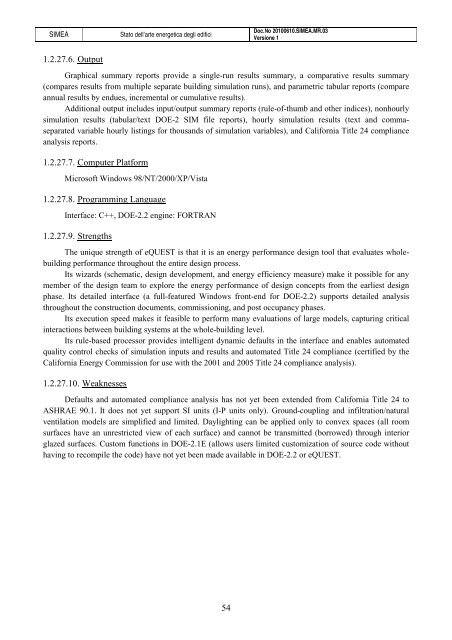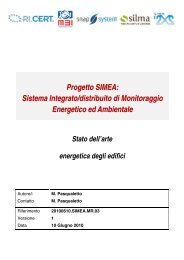Progetto SIMEA - Automatica - Università degli Studi di Padova
Progetto SIMEA - Automatica - Università degli Studi di Padova
Progetto SIMEA - Automatica - Università degli Studi di Padova
You also want an ePaper? Increase the reach of your titles
YUMPU automatically turns print PDFs into web optimized ePapers that Google loves.
<strong>SIMEA</strong> Stato dell’arte energetica <strong>degli</strong> e<strong>di</strong>fici<br />
1.2.27.6. Output<br />
54<br />
Doc.No 20100610.<strong>SIMEA</strong>.MR.03<br />
Versione 1<br />
Graphical summary reports provide a single-run results summary, a comparative results summary<br />
(compares results from multiple separate buil<strong>di</strong>ng simulation runs), and parametric tabular reports (compare<br />
annual results by endues, incremental or cumulative results).<br />
Ad<strong>di</strong>tional output includes input/output summary reports (rule-of-thumb and other in<strong>di</strong>ces), nonhourly<br />
simulation results (tabular/text DOE-2 SIM file reports), hourly simulation results (text and commaseparated<br />
variable hourly listings for thousands of simulation variables), and California Title 24 compliance<br />
analysis reports.<br />
1.2.27.7. Computer Platform<br />
Microsoft Windows 98/NT/2000/XP/Vista<br />
1.2.27.8. Programming Language<br />
Interface: C++, DOE-2.2 engine: FORTRAN<br />
1.2.27.9. Strengths<br />
The unique strength of eQUEST is that it is an energy performance design tool that evaluates wholebuil<strong>di</strong>ng<br />
performance throughout the entire design process.<br />
Its wizards (schematic, design development, and energy efficiency measure) make it possible for any<br />
member of the design team to explore the energy performance of design concepts from the earliest design<br />
phase. Its detailed interface (a full-featured Windows front-end for DOE-2.2) supports detailed analysis<br />
throughout the construction documents, commissioning, and post occupancy phases.<br />
Its execution speed makes it feasible to perform many evaluations of large models, capturing critical<br />
interactions between buil<strong>di</strong>ng systems at the whole-buil<strong>di</strong>ng level.<br />
Its rule-based processor provides intelligent dynamic defaults in the interface and enables automated<br />
quality control checks of simulation inputs and results and automated Title 24 compliance (certified by the<br />
California Energy Commission for use with the 2001 and 2005 Title 24 compliance analysis).<br />
1.2.27.10. Weaknesses<br />
Defaults and automated compliance analysis has not yet been extended from California Title 24 to<br />
ASHRAE 90.1. It does not yet support SI units (I-P units only). Ground-coupling and infiltration/natural<br />
ventilation models are simplified and limited. Daylighting can be applied only to convex spaces (all room<br />
surfaces have an unrestricted view of each surface) and cannot be transmitted (borrowed) through interior<br />
glazed surfaces. Custom functions in DOE-2.1E (allows users limited customization of source code without<br />
having to recompile the code) have not yet been made available in DOE-2.2 or eQUEST.
















